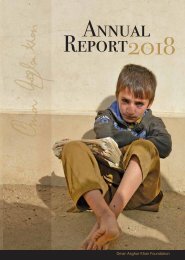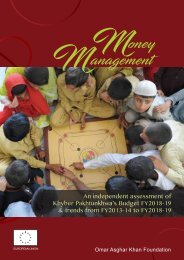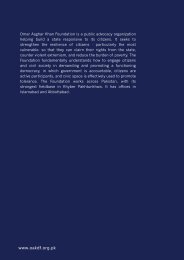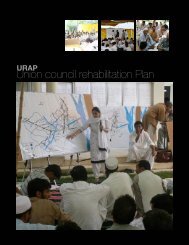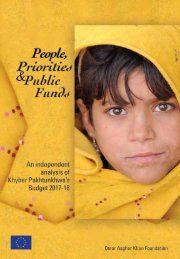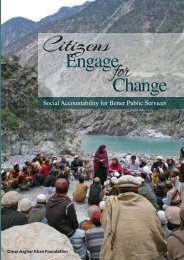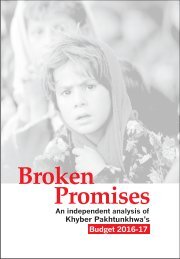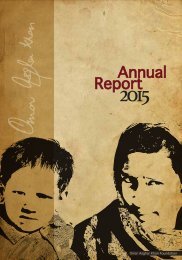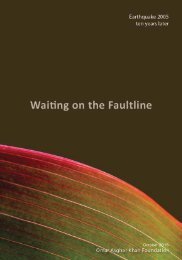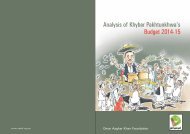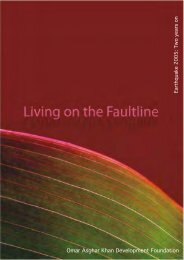Publication of KP budget 2015-16
Create successful ePaper yourself
Turn your PDF publications into a flip-book with our unique Google optimized e-Paper software.
Fair<br />
An analysis <strong>of</strong><br />
Khyber Pakhtunkhwa’s<br />
Funds<br />
Budget <strong>2015</strong>-<strong>16</strong><br />
Fiscal Decentralization for Empowered<br />
Local Government<br />
Omar Asghar Khan Foundation
Omar Asghar Khan Foundation regularly analyses Khyber<br />
Pakhtunkhwa’s <strong>budget</strong> since 2010. Details <strong>of</strong> its annual analysis and<br />
findings for FY2010-11 to FY2014-15 are available at www.oakdf.org.pk<br />
The use <strong>of</strong> the Foundation’s <strong>budget</strong> analysis including material from this<br />
publication is encouraged. Acknowledgement is requested.
Fair<br />
An analysis <strong>of</strong><br />
Khyber Pakhtunkhwa’s<br />
Funds<br />
Budget <strong>2015</strong>-<strong>16</strong><br />
Fiscal Decentralization for Empowered<br />
Local Government
Acronyms<br />
ADP<br />
DHQ<br />
FY<br />
<strong>KP</strong><br />
MNA<br />
MPA<br />
NFC<br />
PFC<br />
PTC<br />
THQ<br />
Annual Development Programme<br />
District Headquarter (hospital)<br />
Financial Year<br />
Khyber Pakhtunkhwa<br />
Member <strong>of</strong> National Assembly<br />
Member <strong>of</strong> Provincial Assembly<br />
National Finance Commission<br />
Provincial Finance Commission<br />
Parents-Teachers Committee<br />
Tehsil Headquarter (hospital)
Fairly funding<br />
local government<br />
Creating an empowered local<br />
government is the ruling Pakistan<br />
Tehreek-e-Insaf’s landmark policy<br />
intervention in Khyber Pakhtunkhwa. Its<br />
success will depend on effective fiscal<br />
decentralization.<br />
Khyber Pakhtunkhwa’s local government<br />
law stipulates allocating “not less than 30<br />
per cent <strong>of</strong> total development funds” to local<br />
government.<br />
An analysis <strong>of</strong> Khyber Pakhtunkhwa’s<br />
<strong>budget</strong> for FY<strong>2015</strong>-<strong>16</strong> shows an allocation<br />
<strong>of</strong> Rs.18.26 billion for ongoing and new<br />
programmes under local government.<br />
Another Rs.30.27 billion is provided<br />
under the District ADP. Combined these<br />
allocations are just about 30 per cent.<br />
But the devil lies in the detail. The sum <strong>of</strong><br />
Rs.18.26 billion provided under local<br />
government is just 10.44 per cent <strong>of</strong> the<br />
total development outlay <strong>of</strong> Rs.174.88<br />
billion. Its use is already decided.<br />
One-third <strong>of</strong> this amount or Rs.6.1 billion<br />
is allocated to six <strong>of</strong> the 25 districts <strong>of</strong> the<br />
province for specified purposes. Much <strong>of</strong><br />
the remaining amount <strong>of</strong> Rs.12.1 billion<br />
includes block allocations for<br />
pre-determined priorities like provision<br />
<strong>of</strong> LED/solar road lights, construction <strong>of</strong><br />
slaughter houses, establishment <strong>of</strong> bachat<br />
bazaars, etc. Such allocations are <strong>of</strong> little<br />
use to local governments that will need<br />
resources for priorities they set.<br />
The allocation <strong>of</strong> Rs.30.27 billion<br />
accounting for 17.31 per cent <strong>of</strong> the total<br />
development funds is unrestricted for<br />
use by local government. While<br />
unrestricted, the distribution <strong>of</strong> these<br />
funds to district governments, tehsil and<br />
village/neighbourhood councils will<br />
depend on decisions made by the<br />
Provincial Finance Commission (PFC).<br />
The Khyber Pakhtunkhwa Local<br />
Government Act 2013 stipulates the<br />
formation <strong>of</strong> a PFC with authority to<br />
devise an equation for distributing public<br />
funds from the province to districts. But<br />
without the equation, or a PFC Award, the<br />
idiom that appears apt is: the more things<br />
change, the more they remain the same.<br />
1
2
Whose job is it, anyway?<br />
Some <strong>budget</strong> allocations in FY<strong>2015</strong>-<strong>16</strong><br />
under provincial control counter the<br />
spirit <strong>of</strong> devolution prescribed in Article<br />
140-A <strong>of</strong> the Constitution <strong>of</strong> Pakistan.<br />
For example, Rs.39.8 billion is allocated<br />
for building additional classrooms,<br />
playgrounds, and the like, through<br />
Parents-Teachers Committees (PTCs). But<br />
school management and interaction with<br />
PTCs should now stand devolved to local<br />
government. Unless this is done, turf<br />
wars are likely between provincial and<br />
local governments especially if different<br />
political parties are in charge in the<br />
province and district levels.<br />
Such jurisdictional confusion may<br />
compound the provincial government’s<br />
inability to deliver social services like<br />
quality education or put in place<br />
institutional mechanisms required for<br />
implementing Article 25-A <strong>of</strong> Pakistan’s<br />
Constitution mandating the provision <strong>of</strong><br />
free and compulsory education to all<br />
children aged 5-<strong>16</strong> years.<br />
3
Some get more, some less<br />
The allocation <strong>of</strong> public funds to districts<br />
reconfirms the dominance <strong>of</strong> patronage<br />
politics. Generous amounts are allocated<br />
to districts that include constituencies <strong>of</strong><br />
powerful MNAs and MPAs from the<br />
ruling coalition parties.<br />
Nowshera, the home district <strong>of</strong> the Chief<br />
Minister, has received Rs.5.3 billion or<br />
3.08 per cent <strong>of</strong> the total development<br />
outlay. During the previous regime, in<br />
FY2012-13, the same district was<br />
allocated Rs.1.5 billion or 1.54 per cent <strong>of</strong><br />
total development funds. The increase in<br />
absolute terms and also as a percentage<br />
<strong>of</strong> total development funds is significant,<br />
despite no apparent change in the<br />
district to merit increased allocations.<br />
Similarly, Rs.2.6 billion is allocated for<br />
Swabi which is the homebase <strong>of</strong> the<br />
Speaker <strong>of</strong> the Provincial Assembly, Mr.<br />
Asad Qaiser, and also <strong>of</strong> the Senior<br />
Minister for Health Mr. Shahram Khan<br />
Tarakai belonging to the coalition partner<br />
Awami Jamhuri Ittehad. The other<br />
coalition partner, Jamaat-e-Islami, has<br />
also benefited. For example, Rs.1.3<br />
billion is allocated for Upper Dir, which is<br />
the constituency <strong>of</strong> Jamaat-e-Islami’s Mr.<br />
Inayat Ullah.<br />
While Khyber Pakhtunkhwa’s three<br />
power districts have received a total<br />
allocation <strong>of</strong> Rs.10.6 billion or 5.38 per<br />
cent <strong>of</strong> the development funds, its seven<br />
poor southern districts <strong>of</strong> Bannu, Dera<br />
Ismail Khan, Hangu, Karak, Kohat, Lakki<br />
Marwat and Tank have been allocated<br />
about half <strong>of</strong> this amount or Rs.5.5<br />
billion. This is merely 3 per cent <strong>of</strong> the<br />
province’s total development outlay. In<br />
percentage terms allocations for the<br />
southern districts have remained the<br />
same as the preceding FY2014-15.<br />
4
5
Hazara is also unfairly treated. The<br />
region’s districts <strong>of</strong> Abbottabad,<br />
Battagram, Haripur, Kohistan, Mansehra<br />
and Torghar, cumulatively received Rs.5.4<br />
billion or 3.1 per cent <strong>of</strong> the total<br />
development outlay.<br />
Allocating 5.38 per cent to three power<br />
districts and only 3 per cent to seven<br />
poor southern districts or 3.1 per cent to<br />
the entire Hazara region is not fair play.<br />
If the provincial government intends to<br />
establish open, transparent and<br />
accountable governance it must<br />
equitably distribute public funds, giving a<br />
fair chance <strong>of</strong> accessing social services<br />
and development opportunities to all<br />
citizens <strong>of</strong> the province, those that voted<br />
for or against the ruling parties.<br />
3<br />
Total<br />
Swabi<br />
1.54<br />
Nowshera<br />
Dir Upper<br />
0.76<br />
Power<br />
Districts<br />
6<br />
Hazara<br />
Districts<br />
Total<br />
Tor Ghar<br />
Mansehra<br />
Kohistan<br />
0.17<br />
0.41<br />
Abbottabad 0.69<br />
Battagam<br />
Haripur<br />
0.08<br />
0.87<br />
0.9<br />
3.08<br />
3.12<br />
5.38<br />
7<br />
Southren<br />
Districts<br />
Total<br />
Lakki Marwat<br />
Tank<br />
Kohat<br />
Karak<br />
Hangu<br />
D I Khan<br />
Bannu<br />
0.11<br />
0.05<br />
0.34<br />
0.27<br />
0.74<br />
0.72<br />
0.95<br />
3.18<br />
6
Blocked transparency<br />
Allocations to the three power districts,<br />
possibly compelled by political<br />
considerations, reflect a feudal mindset in<br />
which patronage continues to thrive. They<br />
also negate the provincial government’s<br />
claimed strong commitment to open,<br />
transparent and accountable governance.<br />
Further evidence <strong>of</strong> failure to match<br />
actions with intended transparency is the<br />
retention <strong>of</strong> Rs.124 billion or a staggering<br />
71 per cent <strong>of</strong> total development funds in<br />
block allocations, giving unlimited<br />
discretionary powers to politicians and<br />
bureaucrats to move amounts around<br />
within the purpose stated for the block.<br />
A comparative analysis <strong>of</strong> block<br />
allocations since the present government<br />
took <strong>of</strong>fice shows an upward trend as a<br />
percentage <strong>of</strong> total funds, and a sharp<br />
increase in real terms.<br />
Rs. 79.5<br />
Billion<br />
FY2013-14<br />
Rs.94<br />
Billion<br />
FY2014-15<br />
In FY2013-14 the block amount was<br />
Rs.79.5 billion or 67.42 per cent <strong>of</strong> the<br />
total <strong>of</strong> Rs.118 billion. In FY2014-15 it<br />
increased to Rs.94 billion or 67.46 per<br />
cent <strong>of</strong> the total <strong>of</strong> Rs.139.8 billion. And in<br />
FY<strong>2015</strong>-<strong>16</strong> it has swelled to Rs.124 billion<br />
or 71 per cent <strong>of</strong> the total development<br />
outlay <strong>of</strong> Rs.174.8 billion.<br />
Rs.124<br />
Billion<br />
FY<strong>2015</strong>-<strong>16</strong><br />
7
Reduced funds, deprived basic services<br />
Adding insult to injury is reducing<br />
development funds in absolute terms and<br />
also as a percentage <strong>of</strong> the total. District<br />
Abbottabad, for example, is allocated<br />
only Rs.1.2 billion or 0.69 per cent <strong>of</strong> the<br />
total development outlay <strong>of</strong> Rs.174.88<br />
billion in FY<strong>2015</strong>-<strong>16</strong>. This is less than half<br />
<strong>of</strong> the 1.6 per cent, or Rs.2.2 billion,<br />
allocated in the preceding year.<br />
Last year’s allocation appears as adhoc as<br />
this year’s much reduced level <strong>of</strong><br />
development funds given to the district. If<br />
the criteria applied for the NFC Award is<br />
used to determine fiscal transfers from<br />
the province to districts, then Abbottabad<br />
should receive 4.72 per cent <strong>of</strong> total<br />
development funds.<br />
This means that in FY<strong>2015</strong>-<strong>16</strong>, the district<br />
should get Rs.8.25 billion and in the<br />
preceding year Rs.6.59 billion. In other<br />
words, cumulatively in two years<br />
Abbottabad has been denied a total due<br />
share <strong>of</strong> Rs.11.44 billion in development<br />
funds, depriving its people access to<br />
healthcare, education and other basic<br />
facilities. The following case studies are<br />
illustrative.<br />
8
Healthcare & education in Hazara<br />
Repeated commitments were made by the<br />
Chief Minister and other senior members<br />
<strong>of</strong> the provincial cabinet to complete “on<br />
war-footing” the upgradation <strong>of</strong> DHQ<br />
Abbottabad that serves as a critical<br />
referral point for patients from across<br />
Hazara. The urgency expressed in public<br />
pledges sharply contrasts with the glacial<br />
pace <strong>of</strong> government action. According to<br />
available data, the PC-1 for the<br />
upgradation was approved in 2012. Its<br />
total cost was estimated as Rs.200 million,<br />
and it was due for completion in 20<strong>16</strong>. In<br />
FY2013-14 an allocation <strong>of</strong> Rs.5 million<br />
was made and another Rs.20 million<br />
provided in FY2014-15. Both allocations<br />
remained unused.<br />
No work has started on the ground. And<br />
now, in FY<strong>2015</strong>-<strong>16</strong> a further Rs.30 million<br />
is allocated. Will the government be able<br />
to use this new allocation? Or will this<br />
allocation, like its predecessors, remain<br />
unutilized? The government has further<br />
muddled the matter by issuing a<br />
notification in FY2014-15 asking for<br />
submission <strong>of</strong> a modified PC-1 in which all<br />
construction work is to be deleted.<br />
Without construction work, will it be<br />
possible to fully upgrade the DHQ?<br />
DHQ<br />
Abbottabad<br />
DHQ Abbottabad awaits upgradation to better serve as an important referral healthcare facility<br />
9
Healthcare & education in Hazara<br />
In the remote mountains <strong>of</strong> Kohistan a<br />
newly built THQ is wasting away due to<br />
government neglect. It was inaugurated<br />
on 1st February 2007 by an MPA from the<br />
Muttahida Majlis-e-Amal. Its sprawling<br />
structures include a 100-bed capacity,<br />
operating theater, emergency care and<br />
other much needed healthcare facilities.<br />
These can potentially provide direly<br />
needed healthcare to the people <strong>of</strong> this<br />
district which is one <strong>of</strong> the poorest in the<br />
province and the country. Despite the<br />
passage <strong>of</strong> eight years, and <strong>budget</strong><br />
allocations made in FY2013-14 and<br />
FY2014-15, the THQ is not functional due<br />
to lack <strong>of</strong> staff and equipment.<br />
THQ Pattan<br />
Kohistan<br />
10<br />
Sprawling building <strong>of</strong> the THQ Pattan awaits staff, equipment and medicines
Healthcare & education in Hazara<br />
Ten years ago the horrific 2005<br />
earthquake wreaked havoc in Hazara.<br />
According to government data, 6,300<br />
schools were destroyed across the<br />
affected region. Many surviving but<br />
damaged school structures were torn<br />
down with the promise to “build back<br />
better.” Between 2005-2014 less than half<br />
<strong>of</strong> the total schools were rebuilt.<br />
In FY2014-15, the provincial government<br />
allocated Rs.300 million for the<br />
reconstruction <strong>of</strong> 760 schools affected by<br />
the earthquake. Of this amount only<br />
Rs.4.1 million appears expended.<br />
For ten long years, an entire generation <strong>of</strong><br />
young children has been forced to study<br />
in makeshift classrooms. Many <strong>of</strong> them<br />
are still asking: “when will my school be<br />
rebuilt?”<br />
Earthquake-affected<br />
schools, Hazara<br />
Awaiting government attention: abandoned, incomplete government school in village Kolay, District Battagram<br />
11
12
Extraordinary opportunity to change lives<br />
Khyber Pakhtunkhwa has an extraordinary<br />
opportunity to break away from<br />
patronage politics and firmly establish<br />
openness and transparency.<br />
It must move swiftly to form the Provincial<br />
Finance Commission stipulated in Khyber<br />
Pakhtunkhwa’s local government law. It<br />
must use its authority to devise an<br />
equation for distributing public funds<br />
from the province to districts.<br />
Such a PFC Award, on the lines <strong>of</strong> the NFC<br />
Award, can effectively reduce<br />
wide-ranging discretionary powers <strong>of</strong> the<br />
executive and help determine<br />
evidence-based fiscal transfers giving<br />
equitable access to social services and<br />
development opportunities across the<br />
province.<br />
Much <strong>of</strong> the government’s dysfunction<br />
can be reversed through an effective local<br />
government. The electoral process that<br />
began on 30 May <strong>2015</strong> concluded with<br />
the election <strong>of</strong> Nazims and Naib Nazims<br />
on 30 August <strong>2015</strong>. Elected councils are<br />
now in place at the district, tehsil and<br />
village/neighbourhood levels. With<br />
elected councilors closer to the people, it<br />
is possible that some <strong>of</strong> the public<br />
grievances related to government<br />
performance can be addressed. But<br />
effective local governments are only<br />
possible if there is effective fiscal<br />
decentralization.<br />
Equally critical will be the ability <strong>of</strong> local<br />
governments to efficiently use funds for<br />
equitable development.<br />
A fair equation, devised in close<br />
consultation with districts, will give a basis<br />
for allocating funds that is not hostage to<br />
political expediency or used to victimize<br />
political opponents. It will also provide<br />
critically required fiscal space to devolved<br />
systems <strong>of</strong> local governance.<br />
13
Local government must be supported in<br />
mapping each village, neighbourhood,<br />
tehsil and district <strong>of</strong> Khyber Pakhtunkhwa<br />
showing all available or missing public<br />
services. This data should be used to draw<br />
up development plans using the principles<br />
<strong>of</strong> subsidiarity and cost-effectiveness. Until<br />
this is done, public funds may continue to<br />
be used to appease constituents or<br />
punish opponents rather than providing<br />
services and development opportunities<br />
to all, especially the more deserving.<br />
If the province is able to seize this<br />
extraordinary opportunity to break away<br />
from patronage politics and firmly<br />
establish open, transparent and<br />
accountable systems <strong>of</strong> devolved<br />
governance, it can rightfully claim that<br />
change has come to Khyber Pakhtunkhwa.<br />
14
15




